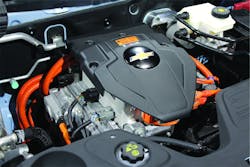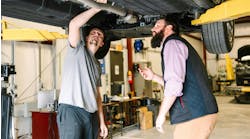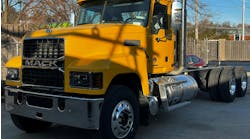What the auto repair and collision specialist needs to know about EVs
What you will learn:
• EVs will become mainstream and can't be avoided
• Seek out proper training to stay ahead of the curve
• Identifying Hybrid or EVs can be tricky, be cautious
The unknown is scary.
Apprehension can come from not knowing what the dentist will tell you, how much that weekly grocery bill will be, and for the consumer, “What is wrong with my car, and how much will it cost me to get it fixed?” There is also apprehension on the other side of the auto repair business, and that's ok.
Electric and hybrid electric vehicles are fast becoming a significant portion of the vehicles collision repair shops are and will be seeing. With today's EV sales growth and projected growth, it is no longer an option for a viable business to turn that work away. Most of the initial concerns over dealing with EV technology are starting to wear away for most shops, but there is still a lot of misinformation and "fear of the unknown" out there. However, with a bit of training, common sense, and awareness of the dangers associated with EV high voltage systems, electric cars and trucks can grow into a significant segment of your bottom line, especially when many of your competitors are declining this type of work.
Seek out training
It always starts with training. If the reader gains one thing from this article, it should be for them to seek out training on how EVs operate, gain knowledge on their specialized and high voltage components, and most importantly, learn how to correctly and safely disable the vehicle by isolating all high- voltage power to the vehicle's battery pack before the initiation of work.
A great place to start to acquire information is from the vehicle's OEM repair and safety information. Automotive manufacturers offer a vast amount of information on all vehicles, including their electric offerings. There are also many third-party organizations that provide training, much of which can be accessed online. Another resource for training would be your go-to parts supplier. Many parts chains offer free or low-cost training to their clients, and the segment of their offerings focusing on alternative fuel vehicles is growing.
Another option to gain EV knowledge would be to partner with a local shop that offers EV repair. They can assist in explaining how EVs operate, how to disable them, and how to do a correct post-repair vehicle review to ensure both that the collision repair has been completed correctly and that the high-voltage systems are also working well. It’s not a replacement for quality training, but it’s a starting point.
An excellent place for basic information on a particular electric vehicle can be found under the manufacturer's emergency response documentation, which can be found relatively easily on the web. Each car sold in the U.S. must have a published ERG, or "emergency response guide," designed to assist firefighters, law enforcement, and tow operators on the essential operation, disabling procedures, and component location of electric vehicle systems. This is a great tool and an excellent starting point for a shop when working on EVs as a first step for each electric vehicle that comes into your shop (FIG1).
Identify an EV vehicle as soon as it enters your facility
Just like a firefighter arriving at the scene of an accident, a collision repair shop should first recognize the type of vehicle it is repairing. Relying on the consumer or the referral shop to correctly define the type of vehicle you will be servicing is no longer an option. Sure, it is easy to recognize a Prius because of its unique body lines, but what about those vehicles offered as either hybrid or as a gasoline drivetrain? Recognizing an EV for what it is IMMEDIATELY upon its arrival at your facility is the first step in electric vehicle repair. This will set the stage for correct repair procedures and, more importantly, for safety (FIG2).
Once a vehicle has been recognized as having a high-voltage system, a good practice for all shops is to label it as such. Either through a grease pencil "EV" written on the front and rear glass, a bright red hangtag on the wiper arm, or simply taping a piece of paper to the hood with "Electric" written on it, clearly labeling an EV as it enters your shop is a best practice everyone should follow. This label will inform everyone -- from the service writer to the detail crew -- that high-voltage components and batteries are present in the vehicle, laying the groundwork for a safe vehicle repair pathway.
Once a vehicle has been recognized as one that possesses a high voltage propulsion system, a proper disabling procedure must be followed so that the components connected to the HV battery cannot be energized. On many electric vehicles, not only are there electric motors for propulsion, but there are also components for power steering, air conditioning, heaters, inverters, converters, and others that operate under high-voltage power. Fortunately for all of us, the automotive industry has, for a change, built in a standard and universal way of recognizing many of these components. Since the late 1990s, all high voltage cabling and connections have been colored bright orange to clearly show where high-voltage power is transported. The components themselves may not be orange, but if an orange cable is connected to it, it should be clear that it is a high voltage component (FIG3).
Electric vehicles, both pure electric (no gasoline or diesel motor) and hybrid electric (those with both an electric and gasoline engine), have two separate electrical systems. The first is the one you are familiar with, the 12V DC system used for lights, horns, computers, radio, and other low-voltage components we all are very familiar with. The second system is the high-voltage system that powers the electric traction motor and other high voltage components. It operates separately from the low voltage 12V system. This voltage can be as low as 200v but as high as 800v or more, a level that can quickly cause significant injury or death to the unaware technician (FIG4).
A significant safety feature for the high-voltage circuit is the High-Voltage Interlock, or HVIL. The HVIL uses a low-voltage signal to monitor the high-voltage current integrity and disconnect the battery's voltage if an error is detected. How does this relate to collision repair specialists' work? Suppose a major collision with multiple components in the EV drivetrain is affected. In that case, the HVIL can prevent a still-compromised EV system from initializing if hidden or incorrect procedures have taken place (FIG5).
A common and recommended method of disabling the high-voltage system for repair is twofold. The first is to remove the 12V battery from the vehicle, as the high-voltage circuits are controlled with low-voltage relays that require a 12v power source. The second step is the service disconnect. Almost all electric vehicles are equipped with this disconnect, which can be found through the OEM service information. Usually bright orange in color, removing the disconnect from the car assures that the high voltage is removed from the vehicle's circuitry and is isolated in the battery. However, it is always recommended to check any circuit with a "live-dead-live" test with the appropriate high voltage DVOM and high voltage certified leads before beginning repair work.
As a list to attempt to shoot down some misconceptions:
There is no practical way of totally discharging all the electricity from an EV battery pack, but understanding that the isolation of the electricity to the battery is the critical starting point for a safe vehicle repair.
High-voltage batteries and cables cannot be repaired, only replaced.
High-voltage components can be replaced, but this requires a high skill level of understanding the electric vehicle systems.
Specialized tools, such as insulated hand tools and high voltage lineman gloves, are ESSENTIAL when working on these systems.
A great tool to have is a touchless voltage detector which can quickly test for power in a component or cable
Scan tools are paramount when diagnosing an EV
On a significant collision when a battery pack has been damaged, the collision repair technician must contact the OEM and request its procedure for handling a damaged pack. These batteries need to go through specific disposal and/or recycling procedures, require specific shipping containers, and may need to be submitted as a total or partial core for a replacement battery, depending on the level of damage.
So the vehicle has been disabled with the high voltage isolated to the battery pack. Repair work can now use conventional collision repair techniques, but the challenges aren't quite over yet. Paint curing is the final challenge to be faced. Many vehicle manufacturers state that any battery heating beyond 130 degrees Fahrenheit can cause irreversible battery pack damage, and alternate curing methods that don't involve the curing booth must be used. An option on some vehicles can be removing the battery pack before work begins, allowing for conventional curing booth use. This brings into focus the importance of gathering vehicle-specific information when involved in all aspects of a repair, and falling back on "the way we've always done it" can not only cause damage to the vehicle but damage to you (FIG6).





